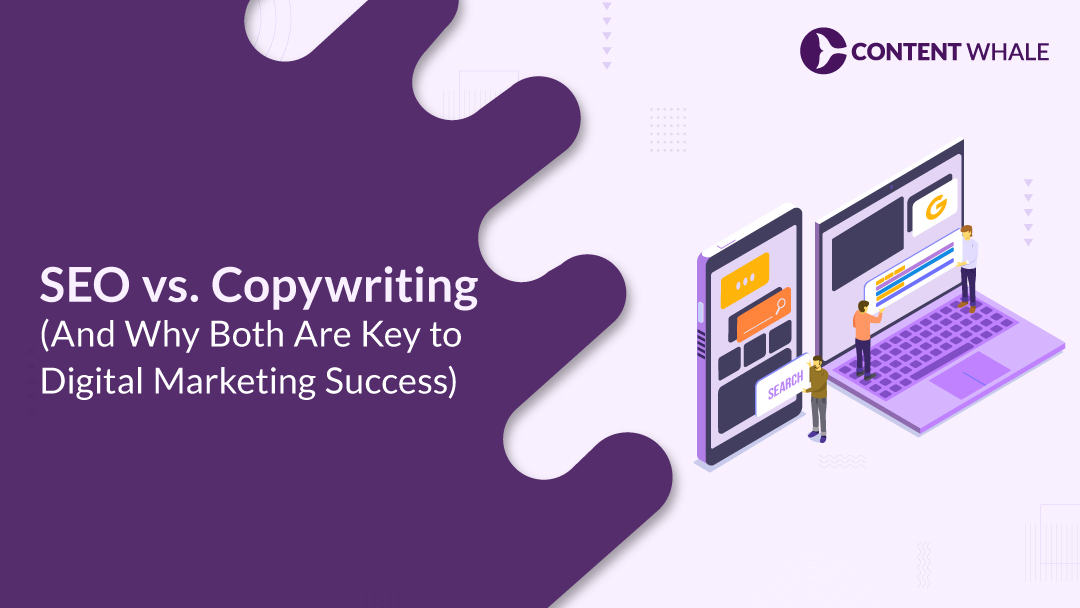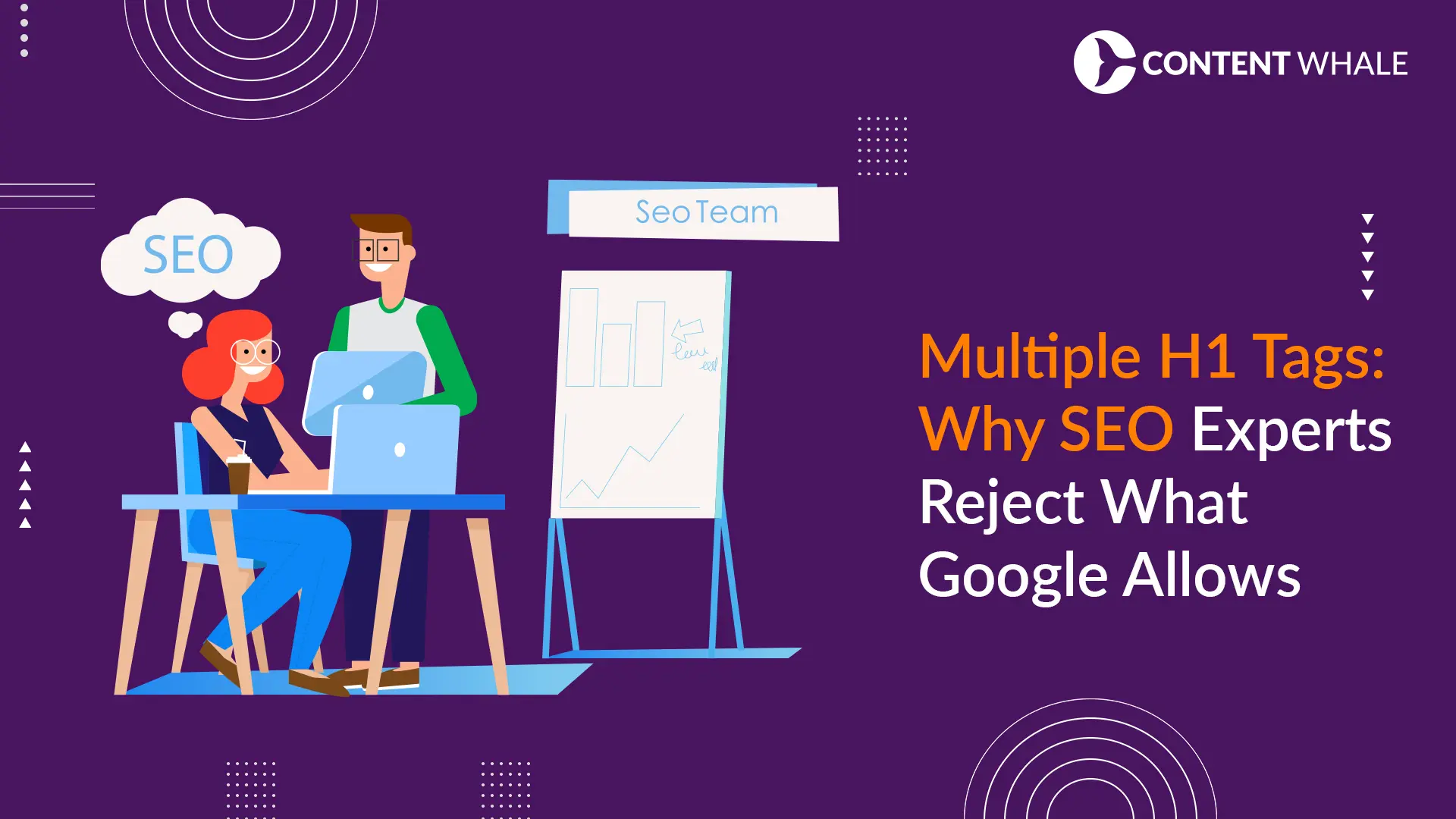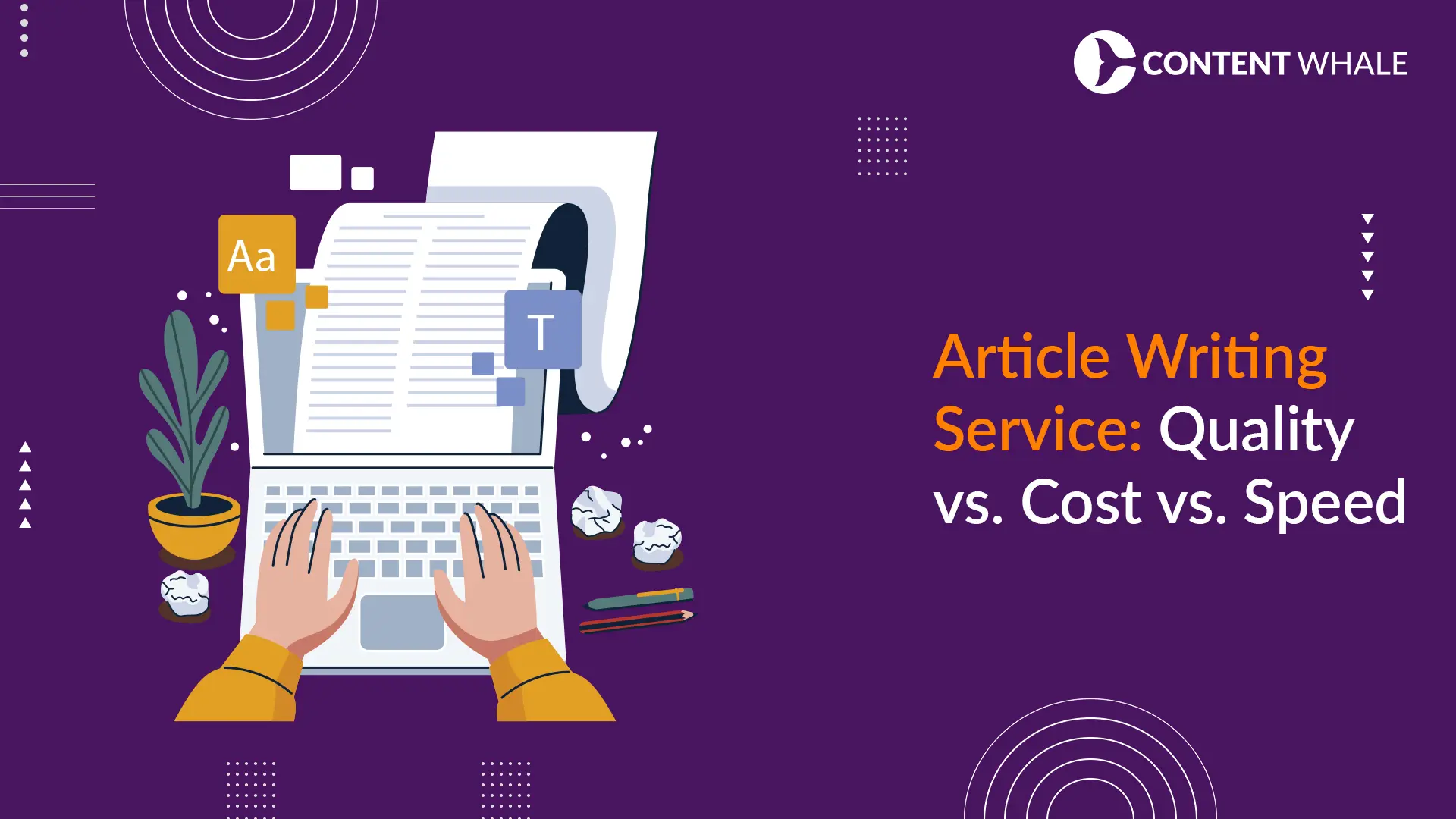Every digital business faces a fundamental question: SEO vs Copywriting — which should take priority? SEO drives visibility, while copywriting aims to convert that attention into action. But choosing between them can limit your potential. The real key to success lies in understanding how these two powerful elements work together in any digital marketing strategy.
On the one hand, SEO writing focuses on helping your content rank higher in search engines by incorporating keyword optimization and aligning with user intent. On the other hand, conversion copywriting uses persuasive writing to engage readers and guide them through your marketing funnel toward a conversion. By leveraging both, you can create content that not only attracts organic traffic but also converts visitors into loyal customers.
As businesses look to optimize their content marketing efforts, finding the right balance between SEO content writing and persuasive copywriting is more important than ever. It’s not about choosing one over the other, but about integrating both to enhance search engine visibility and audience engagement. Whether you’re working on long-form content for blogs or short-form content like landing pages and meta descriptions, combining SEO and copywriting can lead to a seamless user experience that drives lasting results.
1. What is SEO Writing?
SEO writing involves crafting content specifically designed to improve a website’s visibility on search engines. It is a key component of any digital marketing strategy because it helps businesses gain organic traffic through targeted keyword optimization and by aligning content with user intent.
To help break down the essentials, here’s how SEO writing works:
A) Focus on Keyword Optimization
SEO writing revolves around the careful use of primary keywords and LSI keywords (related terms) that are naturally incorporated into the content. Keywords like SEO content writing, search engine ranking, and conversion copywriting help align the content with what users are searching for.
Key strategies include:
- Researching high-impact keywords relevant to your audience.
- Ensuring keywords are used naturally in titles, headings, and throughout the content.
- Avoiding keyword stuffing, which can harm rankings.
B) Understanding User Intent
For content to rank well, it must meet the needs of the user. Search engines now prioritize content that matches the user intent behind a search query. If users are looking for product information, reviews, or how-to guides, your content should deliver exactly that.
SEO writing helps bridge the gap between what users are searching for and the content they find, ensuring higher search engine visibility and better engagement.
C) Long-Form vs. Short-Form Content
While long-form content (typically 2,000 words or more) tends to perform better in SEO, short-form content can still be effective when targeted properly.
- Long-form content allows for more thorough exploration of topics and higher keyword density, which improves audience engagement and supports your content strategy.
- Short-form content works well in landing page optimization or meta descriptions, where brevity is key to maintaining user interest and driving conversions.
D) Structured Content for Better Visibility
Search engines reward well-structured content. Breaking up your content with subheadings, bullet points, and lists makes it easier for users and search engines to understand the context and value of your content. This also positions your content for potential featured snippets, further improving its visibility.
Tips for structuring content:
- Use subheadings to divide your content into digestible sections.
- Add bullet points or lists to improve readability and organization.
- Ensure the content flows naturally while strategically incorporating keyword optimization.
2.What is Copywriting?

Copywriting is the art of writing persuasive text that compels readers to take a desired action, such as making a purchase, signing up for a service, or clicking a link. It plays a central role in shaping brand identity, driving sales, and building connections with the target audience. Here’s a breakdown of key elements that define effective copywriting:
A) Focus on Persuasion and Emotional Appeal
Copywriting centers around using persuasive writing techniques that tap into the emotions of the audience. Whether the goal is to drive conversions or build brand voice, the copy is crafted to resonate with the reader’s needs, desires, and pain points. This emotional connection can influence decision-making, making the copy more impactful.
B) Short-Form and Long-Form Content
Copywriting comes in many formats, ranging from short-form content like social media ads and call to action buttons to long-form content such as product pages and landing pages. While short-form content aims for quick conversions, long-form copy provides in-depth information and builds a stronger case for the product or service.
C) Targeted Copy and Audience Engagement
Copywriting must be highly tailored to its audience. By understanding buyer personas and their specific needs, copywriters create messages that align with the customer’s journey through the marketing funnel. From attention-grabbing headlines to concise product descriptions, each piece of copy is designed to enhance audience engagement and increase audience conversion.
D) The Role of Storytelling and Brand Voice
Storytelling in copywriting helps create memorable brand experiences. When done right, it reflects the brand’s personality, builds trust, and makes the copy more relatable. By using a consistent brand voice, copywriters can distinguish the business in a crowded market and foster a deeper connection with their audience.
E) Incorporating SEO into Copywriting
Although traditional copywriting focuses on persuasion, modern approaches often incorporate SEO content writing techniques. By blending keyword optimization with compelling copy, businesses can improve their search engine ranking while still delivering a message that resonates with readers. This ensures the content is both engaging and easy for search engines to discover.
3. The Differences Between SEO and Copywriting
While SEO writing and copywriting share the same goal of driving traffic and conversions, their approaches and techniques differ significantly. Understanding these differences can help businesses make informed decisions about their content strategy. Let’s break down how SEO vs Copywriting compares across key factors:
A) Content Purpose: Ranking vs. Persuasion
- SEO writing focuses on improving search engine ranking by integrating keyword optimization and creating content that meets user intent. The primary goal is to attract organic traffic by aligning the content with what people are searching for.
- Copywriting, on the other hand, is about persuasion. It aims to engage the reader, evoke an emotional appeal, and encourage them to take action, such as clicking a call to action or making a purchase. The focus is on audience conversion and delivering a message that resonates with the reader.
B) Content Length and Structure
- SEO content writing often favors long-form content because longer articles provide more opportunities to include keywords, cover the topic comprehensively, and rank for multiple search queries. This type of content is ideal for blog posts, guides, and articles that answer user questions in depth.
- Copywriting, in many cases, uses short-form content like ads, landing pages, and product descriptions. The goal is to communicate a message quickly and effectively, making every word count. While landing page optimization can involve both long and short-form content, the message needs to be clear, engaging, and action-driven.
C) Target Audience and Approach
- SEO writing is designed to attract visitors via search engines. The focus is on writing for a broader audience, optimizing for algorithms, and increasing search engine visibility.
- Copywriting, on the other hand, targets specific buyer personas and works deeper in the marketing funnel. It aims to engage users who are already aware of the brand or product, guiding them toward making a decision through persuasive, targeted copy.
D) User Journey: Information vs. Action
- SEO content is often informational content, designed to educate or provide solutions to user queries. This content works well for the initial stages of the user journey, helping users discover a brand or product.
- Copywriting, however, drives action. It’s typically found at the later stages of the funnel where users are ready to make a decision. Whether it’s a sign-up form, purchase button, or meta description for a product, conversion copywriting guides users toward completing the desired action.
E) Metrics for Success
- For SEO writing, success is measured through metrics like search engine ranking, organic traffic, and bounce rate. The aim is to increase visibility and ensure users stay on the page for longer.
- For copywriting, the key metrics include click-through rates, conversions, and engagement. Copy that converts well is considered successful if it directly leads to sales, sign-ups, or other actions.
| # | Factor | SEO Writing | Copywriting |
| 1 | Purpose | Focuses on improving search engine rankings and driving organic traffic. | Persuades readers to take specific actions, like buying or subscribing. |
| 2 | Audience | Aims to satisfy user intent by providing valuable information. | Directly targets buyer personas to engage and convert them. |
| 3 | Content Length | Typically favors long-form content for ranking and in-depth coverage. | Often uses short-form content for quick, impactful messaging. |
| 4 | Metrics for Success | Measures success through search engine ranking, organic traffic, and bounce rate. | Measures success through conversion rates, click-through rates, and engagement. |
4. Why You Need Both SEO and Copywriting in Your Digital Marketing Strategy

In today’s competitive digital environment, businesses cannot afford to choose between SEO and copywriting. Both are integral to building a successful digital marketing strategy that attracts traffic and converts visitors. Here’s why you need to leverage both:
A) SEO Brings Traffic; Copywriting Converts
- SEO is crucial for search engine visibility. By optimizing content with targeted keyword optimization and aligning it with user intent, businesses can improve their rankings on search engine result pages (SERPs). This is where SEO shines—driving organic traffic to your website by ensuring your content matches the needs of users searching online.
- Copywriting, on the other hand, is all about persuasive writing. It takes that traffic and turns it into conversions by using emotional appeal, clear messaging, and a strong call to action. Whether you’re writing a compelling landing page or an engaging blog post, conversion copywriting ensures your visitors take action, such as subscribing or making a purchase.
B) Creating a Seamless User Experience
- A well-optimized piece of content should cater to both search engine algorithms and the human reader. SEO content writing ensures that users can find your content easily, but it’s the copy that keeps them engaged once they arrive. By crafting content that is both informative and engaging, you create a user experience that satisfies both search engine ranking factors and audience needs.
- Good copywriting ensures that the tone and style of your content match your brand voice, further strengthening your connection with your target audience.
C) Balancing Keyword Optimization with Engaging Copy
- While SEO writing emphasizes keyword optimization, overloading your content with keywords can hurt its readability. This is where copywriting plays a crucial role. It ensures that keywords are integrated naturally without compromising the flow and engagement of the content. A balanced approach will improve your search engine ranking while still providing value to the reader.
- Copywriters also know how to use latent semantic indexing (LSI) keywords, which are related terms that give search engines more context about the content without the need for keyword stuffing.
D) Long-Term Strategy for Growth
- SEO brings sustained growth by gradually increasing your visibility in search results, while copywriting delivers immediate conversions. Together, they build a long-term strategy that consistently brings new visitors to your site and encourages them to return.
- Regularly updating and optimizing your SEO content while refining your copy ensures your website stays relevant and continues to rank well over time.
5. How to Strike the Right Balance Between SEO and Copywriting
Creating content that is both optimized for search engines and engaging for readers can be challenging, but achieving the right balance is essential. Here’s how to ensure your content ranks well and converts effectively:
A) Prioritize Readability Without Sacrificing SEO
- Avoid keyword stuffing: Instead of overloading your text with keywords, focus on integrating them naturally. Use them in key areas like headlines, subheadings, and throughout the body in a way that maintains the flow of the text. This ensures your content reads smoothly while still signaling relevance to search engines.
- Focus on flow: Keep sentences and paragraphs concise, and maintain a logical flow to keep readers engaged. Break up content with appropriate headings to improve both readability and SEO.
B) Write for Both Users and Search Engines
- Understand user intent: When planning content, think about what your audience is searching for. Use keyword research to guide your content, but always ensure that the final product addresses user needs and is easy to read.
- SEO writing improves visibility, but copywriting must engage and persuade. Integrate persuasive elements like calls to action and emotional appeal without disrupting keyword usage.
C) Use Clear Structure and Engaging Design
- Subheadings and lists: Organize your content with clear subheadings (H2, H3) to improve readability. This also helps search engines understand the structure of your page. Use bullet points or numbered lists where appropriate to enhance skimmability.
- Short paragraphs: Readers today often skim content, so break up large chunks of text into smaller, digestible paragraphs. This also improves the user experience, increasing the likelihood of them staying on your page longer.
D) Maintain User Experience with Emotional Appeal
- Engage through storytelling: Incorporate elements of storytelling and brand voice into your content. Emotional hooks make your content relatable and keep users engaged, which can ultimately drive conversions.
- Enhance user experience: SEO helps users find your content, but copywriting helps them stay and convert. Focus on delivering a seamless user experience by aligning the content’s tone and messaging with your audience’s expectations.
E) Combine SEO Best Practices with Effective Copywriting
- Long-tail keywords: Use specific, long-tail keywords to target niche searches while maintaining relevance. This allows for more natural keyword integration, improving both SEO and readability.
- Internal and external links: Enhance your content with relevant internal and external links. Internal links help guide users deeper into your website, while external links to authoritative sources improve trustworthiness and SEO.
Conclusion

SEO and copywriting are two powerful elements of a successful digital marketing strategy. While SEO ensures that your content is discoverable and attracts the right audience by improving search engine visibility, copywriting drives conversions by engaging readers and compelling them to take action through persuasive language.
By combining these two strategies, you create content that performs well in both search engine rankings and customer engagement. Remember, SEO brings in traffic, but copywriting converts that traffic into loyal customers. To achieve this, ensure that your content is optimized for both search engines and readers by maintaining a balance between keyword optimization and readability. This harmony will ultimately enhance the user experience and boost your overall content marketing efforts.
In short, the key to digital success lies in recognizing that SEO and copywriting are not in competition—they complement each other. Striking the right balance between the two will allow you to not only attract an audience but also engage and convert them effectively.
This blog is crafted by Content Whale, your trusted partner for high-impact, SEO-optimized content that delivers measurable results. If you’re looking to elevate your brand, boost your rankings, and outpace the competition, we’re here to help. Contact us today, and let’s create content that drives success and takes your business to the next level.
FAQs
1. What is the difference between SEO and copywriting?
SEO is all about optimizing content so that it ranks higher in search engine results, driving organic traffic through keyword optimization and understanding user intent. On the other hand, copywriting focuses on creating engaging, persuasive content that convinces users to take action, such as making a purchase or subscribing. Both are vital components of an effective digital marketing strategy.
2. Can I use SEO without copywriting?
It’s not recommended. While SEO can help your content rank on search engines, if your content isn’t engaging or doesn’t speak to your audience’s needs, it’s unlikely to convert. Copywriting is essential for ensuring that the traffic brought in by SEO is effectively turned into leads or sales.
3. How do SEO and copywriting work together?
SEO ensures that people can find your content, while copywriting makes sure they are compelled to take action once they’re there. Combining both helps you rank higher on search engines while also boosting audience engagement and conversion rates.
4. Do keywords still matter for SEO?
Yes, but keyword usage has evolved. Today, search engines prioritize content that aligns with user intent over keyword stuffing. This means that you should focus on naturally incorporating long-tail keywords and LSI keywords to meet the needs of your target audience, rather than overloading your content with primary keywords.
5. Is long-form content better for SEO than short-form content?
Long-form content generally performs better for SEO because it offers in-depth information that can address more queries and capture user intent. However, short-form content like product descriptions and landing page copy can also be effective, particularly when focused on conversion copywriting.





